Menus
- The race in the lead
- Discovery
- GSX-R1000R specificities
- In the saddle
- On track
- Conclusion
- Colors GSX-R1000
- Colors GSX-R1000R
- Suzuki GSX-R 1000 R video test
The race in the lead
Sports motorcycles are often mechanical legends whose rarefaction of renewal increases their exceptional character. Obvious for the highest category, the 1000 cm3, strongly affected by the socio-economic developments of the last 10 years. The pinnacle of technology and now electronics, they are the quintessence of the know-how of manufacturers and the legitimate pride of their owner..
Among the Japanese, some had fallen behind, allowing an increasingly bitter competition to slip away. Thus, BMW S1000RR, Ducati Panigale and Aprilia RSV4 lead a race in frenzied performance. If Kawasaki, with its ZX10-R, kept pace, longer gestations were the prelude to the advent of the Yamaha R1 and then the Honda CBR1000RR. Transfigured, these machines have now mutated into slender and technological mounts, ever more athletic..

A sales and leads icon was still missing. In thirty years, it is more than a million GSX-R passed. But if the GEX ‘marks the spirits, it is also for its harvest of accumulated titles: 15 World Endurance Champion titles and 65 victories in this championship, 2 Masters of endurance titles, 15 Bol d’Or victories , 7 Victories at the 24 Hours Moto, 1 Victory at the 8 Hours of Suzuka…. An extraordinary track record, like its history.
And this family saga is dense. A model 400 is at the origin, but it is indeed the model 750 of 1985 which marks the advent of the GSX-R. A year later appeared the 1100 and its famous four-cylinder "air-oil"…. 130hp at 9,600 rpm, 10.7daNm at 8,200 rpm, 197 kg in a frame of 750 stiffened, His Majesty already incorporates, on his conventional fork, a NEAS anti-dive system and a steering damper. A reverse train appeared in 1990, liquid cooling in 1993 and performance increased. As a result of developments in the Superbike championship, a brand new machine appears for 2001, the GSX-R1000. Now fixed to the liter of displacement, the Suz ‘delivers 161 hp then evolves slowly. It displays 185 hp in 2007 and adopts three injection maps, an electronic steering damper and a new frame. But 5 years pass then without major evolutions. The Suzuki block then gains some improvements and ABS is (finally) available in 2015 ….
Apart from that, hypersport lives on hopes, perpetuating its fame in endurance championships. We can legitimately consider that the Suz ‘, since 2009, has only done facelifts, trying to stay in a race that is also played on marketing. Efficient on the road and less extreme than its friends, the Gex ‘was still losing ground. And with the disappearance of the 600 and 750 from the family, the 1000 now remains the only large-displacement sports representative of the brand. Long announced, the novelty finally appears, transfiguring its intense racing heritage into an absolute of sportiness. To show the importance of its return, Suzuki invites us to Australia, on the Phillip Island circuit, to try the R version of the GSX-R1000 !
Discovery
For its sixth generation, Suzuki is offering a brand new machine, both aesthetically and technically. But, if the delay has now been made up, we especially note modernization choices that are sometimes different from those of the competition, thus favoring a pragmatic aspect and the constant search for reliability inherent in the model…. the DNA of endurance and the innovations of MotoGP, without however technological outbidding. The latter is at the service of a triptych whose statement is in vogue among manufacturers: acceleration, braking, cornering.
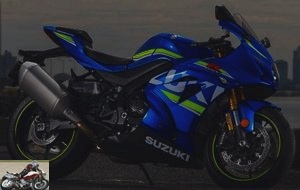
The shaping of this formula also involves a new aesthetic. Fluid, light, the elegant and sharp lines are inspired by those of the MotoGP prototype, also using the graphics on the "Triton" version; a main curve runs along the casing on the top of the machine. Almost unrecognizable with this livery, the 2017 opus however takes up the main family attribute: a front light flanked by air intakes. These can now be copiously extended around a minimalist central optic with LEDs. If the design of the latter may recall that of the MV Agusta, this choice of style and its overall arrangement set it apart from the "Italian school" in vogue (double tapered optics), thus giving a more original personality to the Suz ‘.
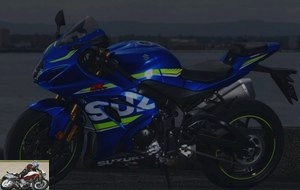
Narrow, the GSX-R1000R is sharpened, in particular at the level of the shoulders of its sides. More compact, the new casing increases aerodynamic efficiency. Smaller, the front surface is 16mm less at its widest point. Positioned closer to the central optic, where air pressure is highest, the new SRAD intake ducts are wider and smoother to improve airflow.
Streamlined, the lines stretch sharply towards the 16 liter tank (-1.5 unit) which is lowered by 21 mm, optimizing the center of gravity. It also allows the pilot to bend more. Redesigned, crotch and sides of the container leave more room for the pilot to position himself in the turn. More contrasted, the curves of the rear loop finalize a seductive aesthetic, which concludes a rear light with leds with dynamic design..
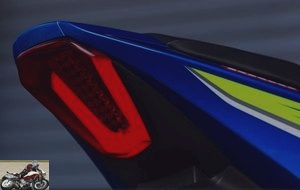
This stern is attached to a simplified removable rear loop, abandoning the old cast plate in favor of a lighter weight aluminum profile (-1 kg) bolted to the main structure. The whole is based on a cycle part with known and proven bases, but completely revised. The aim of the new chassis is to make it easier to steer, turn efficiency and reactivity. All details are in the Technical section but here is a summary below.
Aluminum perimeter structure, the frame narrows by 20 mm and supports an all-new four-cylinder, a major element of the new GSX-R. More compact, the unit straightens by 6 °, thus advancing 20 mm towards the front wheel axle, thus promoting agility in bends and feedback from the steering gear. This important provision is accompanied by equally notable internal innovations. Intake horns and timing by variable pawls, double injection per cylinder, titanium valves…. Suzuki mechanics are top-notch.

The 999.8 cm3 boiler, always "more super-square", reduced its stroke to 55.1 mm (against 57.3 mm) and increased its bore by 1.5 mm or 76 units. Thus the power increases by 17 units with 202 hp at 13,200 rpm, but the torque barely evolves: 11.76 da.Nm at 10,800 rpm and the red zone now begins at 14,500 revolutions. The clutch is anti-dribble and assisted and the electronics are controlled by an inertial unit (IMU) on 6 axes and a processor managing numerous engine parameters and 3 injection / piloting profiles managing traction control (TCS), ABS but also, on the R version, Quick shifter and launch control. Fully adjustable Showa BPF suspensions and for the model, Suzuki "kicks" the BFF elements, associated on both versions of Brembo monobloc radial mount four piston front calipers, attacking 320mm (+10mm) tracks. The GSX-R 1000 and R incorporate the new ABS Track Motion, which works with the IMU (Inertial Measurement Unit). It is possible to deactivate the anti-blocking on the R… version. by removing the fuse. A race-style constructor choice that some might dispute. The 6-spoke rims receive Bridgestone Battlax RS10 wraps in 120 / 70ZR-17 front and 190 / 55ZR-17 rear.
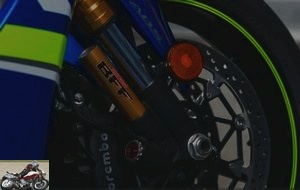
Finally, refined and lighter, the mirrors no longer integrate the indicators, come back to the sides and all the lighting is LED..
A pure competition DNA machine, the new GSX-R does not bother with overly sophisticated elegance. However, the most visible housings sport a pleasant shade of deep black, dressing structured volumes and the integration of peripherals and cables seems correct. However, if we undress the Suzuki, the whole is less homogeneous and lacks charm. Admittedly, the Gex evolves on tracks of speed and not of beauty, but the finish could be worked more in detail. The most obvious is the exhaust. However, although massive, its pentagonal volumes are refined towards the bottom and are much less shocking in real life than in a photo. Discreet, the frame would still have deserved more attention, even in its hidden parts, just like the imposing swingarm. Also, the block could have been enriched with more contrasting side surfaces enriched with noble material. Finally, the casing fixed by torque screws to the flat surfaces receives unvarnished graphics. As usual, the manufacturer of Hamamatsu prefers total efficiency, without fuss, working on more essential qualities already stated: agility, mechanical performance, aerodynamics, ease of adjustment and handling and accessibility..
The GSX-R1000 loses 3 kilos in standard version, for a total of 202 kilos. The GSX-R1000R equips itself more and admits 203 kilos.
GSX-R1000R specificities
Racing version, the Suzuki GSX-R1000R sports high-end equipment. Its breathtaking Showa BFF suspensions resulting from the competition, but not controlled by electronics, deliver ultimate damping. All details in the Technical section.
The R model is also equipped with a lighter Li-Ion battery, a digital "negative" dashboard with a black background, daytime running lights highlighting the top of the forced air intakes, a Quick shifter as standard and Launch control. Its ABS Track Motion also manages the pressure of the calipers according to the inclination. Its weight is 203 kilos, one more than the standard version (additional weight of its equipment).
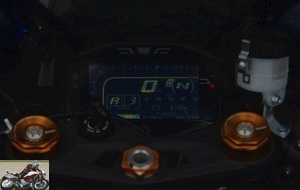
In the saddle
Compactness and ergonomics have dominated ergonomic development. More aerial, the GSX-R1000R takes altitude with 825 mm of saddle height (+ 15 mm). The support on the wrists is sporting standard and the flexion of the legs ditto, without excess. The compactness of the machine is obvious, without making it a child’s toy, keeping the overall handling natural and homogeneous. Although much narrower than its predecessor, the fairings and the fork crown should provide adequate protection. Thus, the Suz ‘is less extreme than the Honda CBR100RR fireblade, or even an Aprilia RSV4 and therefore more welcoming for a large size (1m84).
A little austere, the presentation of the cockpit is in the continual spirit of "sufficient without fuss", could have benefited from a more pleasant trim. The discreetly elegant perforated upper triple tree has a pleasant, finely grained coating, encircling the tops of the Showa fork tubes topped with hydraulic adjustment screws..
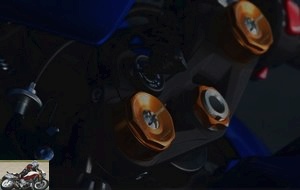
Brake lever adjustable in spacing and radial master cylinder alongside non-braided hoses. The builder prefers an internal silicone construction ensuring comparable efficiency (albeit less durable).
On the left stalk, a large bidirectional pushbutton flanked by a selection button controls the large LCD screen with six brightness levels. This brings together a great deal of information, the most visible of which are bargraph tachometer, tachometer, TCS mode, injection profile and gear indicator engaged. Also, odometer and two partials, fuel gauge, average and instantaneous consumption, but also lap time, water and outside temperature and clock complete the whole. For better visibility, the shifter leds light up above the screen and the speed can be personalized.
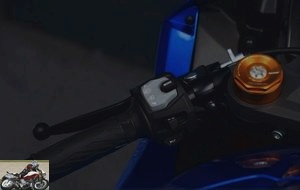
On track
Exceptional test, exceptional organization. The GSX-R1000R awaits us in race condition: engineer and mechanic dedicated by machine, heating blanket and…. ideal weather. Approaching the Phillip Island circuit is a unique experience and a real gift. A present that requires precise learning to get the best out of it. And the machines seem to be at the level of this case. Suzuki hypersports, in their race-beast configuration, are ready to cut the (very) fast Australian track. From their entrails come serious, ample and rapid pulsations, auguring of a ferocious appetite for the track. Finally to accompany us on a few laps, nothing less than the world champion Kevin Schwantz, sometimes paired with the development driver Jurgen Plaschka.
It is with an impatience tinged with apprehension that I take the controls of the Japanese missile for the first three sessions of the five proposed. These offer the machine with standard tire fitting, the Bridgestone RS10. The suspension settings are also standard for the first start and then in circuit configuration for the next two. The TCS traction control is on 3 and the ABS can be deactivated (by fuse….), But I will choose to keep it throughout the day.
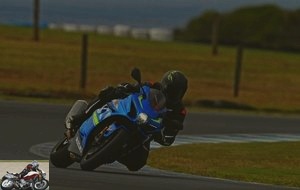
The first laps are rather reserved for learning the trajectories and subtleties of the high speed circuit. A challenge in itself. But already, I note the excellent ergonomics of the Suzuki. As expected from setting in the saddle, the GSX-R1000R offers an appreciable space to the pilot, letting it move with ease on its spine. Compact, the cycle part is intuitive and the engine already gives the impression of a block of explosives. Paved with "sport-road" envelopes, the frame quickly found itself at the limits of the excellent grip of the Bridgestones when relaunched. It is then not uncommon to frankly lose the grip of the rear wheel on the angle. But the Suzuki TCS is very responsive and progressive, immediately putting the machine back on its course. On the bumpy parts of the circuit, the damping also as standard, very safe, is however perfectible in curves at very high speed. Then adjusted to the race profile, the Showa BFFs then make the Gex’1000R a surgical blade of exemplary precision, allowing the sportswoman to be placed more naturally in the pins. Thus masterfully placed on the asphalt, the gums need to go upmarket for the rest of the test..
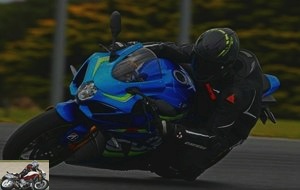
The Bridgestone R10s then make it possible to judge the behavior and the masterful performance of the machine much more finely. Optimized in this way, traction and downforce in curves reveal the full potential of the Suzuki chassis and four-cylinder. Hyper lively, the latter is impressive in terms of power and torque from mid-range. Impressive from 7,000 revolutions, the block turns into a rocket thruster at 9,000 revolutions, ejecting the crew towards the next curve. The work on variable admission and collectors seem to be bearing fruit. Once taken in hand, the circuit seems to have shrunk as the GSX-R1000R blows in a storm at all times. Despite everything, the force of the block passes fully to the ground and the driving machine perfectly, well helped by the extended swingarm and a TCS always finely tuned. In position 2, you have to master the possible glide, but in 3, the skating comes to save too daring acceleration. Adjusted to a more intrusive mode (5 to 9), it then more significantly limits the accelerations on the angle. The merit of this dynamic under control also goes to a remarkably precise grip of the throttle and a controlled injection, making evolutions very easy. Keeping a trickle of gas on the angle is a formality, allowing you to get out of curves with speed, sometimes leaving a long trace of rubber deposited under control…. Not enough to impress Kevin Schwantz who makes me outside.
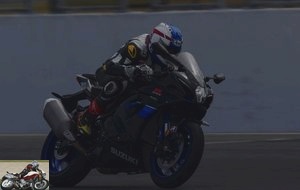
If the A mode retains all the liveliness of the engine, the B mode is barely less alert, calming a little the ardor of the warrior of the slopes. Less relevant, access to the adjustment of the TCS (and of the engine modes) requires two presses on the associated button and to cut off the gas. Dedicated control paddles (Aprilia RSV4 type) could be a real plus to modify the parameters intuitively.
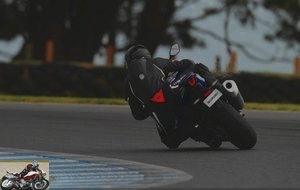
Between its strung portions at high speed, Phillip Island also reserves a few large braking zones, especially on the two hairpins on the route. As powerful as they are progressive, the decelerations are, again under control, the lever pressing against a finger to stop the momentum of the crew. Although narrower, the frame allows the legs to be tightened during these phases, limiting the strain on the arms. The GSX-R1000R dives little, proving excellent management of the hydraulics of its BFF fork and mass transfer. The sinking at the start of the race is rapid then remarkably slowed down. Another good point, the suspension elements are responsive to the settings, allowing the equipment to be finely adjusted to its driving. The Gex ‘then fits naturally and tilts on the angle, precisely following the trajectory defined at the glance.

In charge of regulating the rear axle lift, the Track Motion ABS system is much more convincing than that of the Honda CBR1000RR. Not a single rear wheel sweep or fading is to be noted, the Suz ‘stays in line at all times. Likewise, the ABS is not very intrusive and operates transparently and consistently, even on the most severe braking. These rhythmic transitions underline the perfect functioning of the quick shifter, the speed of which is matched only by the precision of locking, both upshifting and downshifting. In addition, you can easily reverse the selection (MotoGP type) by reversing a frame. Even under full load, the anti-dribble clutch won’t flinch, swallowing gears without a grudge.
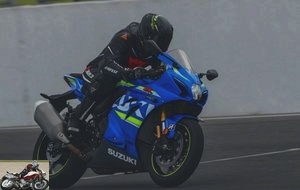
Therefore, the Suzuki leaves full latitude to the pilot to take care of his piloting. Agile and precise, the cycle part also easily allows course corrections. The balance of the Suz ‘is remarkable, showing the relevance of a more forward engine placement. Perhaps less lively in absolute terms than an Aprilia RSV4, on par with a CBR1000RR, the GSX-R1000R does not demerit on angle changes. And the go-arounds are daunting, making the Gex ‘jump in the very present rumbling of the air box. The exhaust then produces a metallic chant at high revs, as the four-cylinder soars through revs and straight ahead. 202 horses rush with fury straight towards the ocean, with a hoarse noise of a turbine. Stable at high speeds and demonstrating perfect heading in fast turns, the GSX-R1000R offers good protection to the air flow. It allows the rider to step back on the saddle and find a very good shelter behind the bubble at more than 280 km / h. Even the gusts of the Australian coast hardly disturb the machine. The first straight line arrives (quickly) I return in 5 and 200 km / h in the big bend, facing the aquatic plain…. a mythical experience.
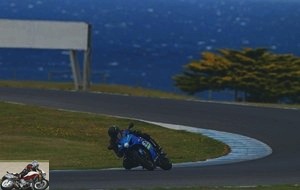
Conclusion
On a demanding circuit, the new Suzuki GSX-R1000R has lived up to its legend, but also the expectations of any sports rider for almost a decade. A monument of power and a show of force at any speed, its four-cylinder is a hymn to family history. Precise, rigid, the cycle part combines talent with agile geometry, high-end suspensions and controlled electronic technology. Born for racing and endurance, like its sisters and now more radical, the Gex’1000R does not however fall into excessive compactness. Without electronic excess, with elegance, but without fuss of style and the only spirit of mechanical mastery and cycle part. Without forgetting the ergonomics of the best.
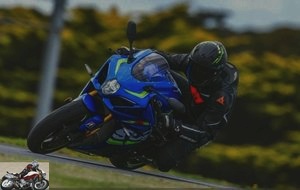
The whole thing makes up a new contender for the throne of queen of circuits, with exciting overall efficiency. Its price, also studied, increases only by 1,300 euros in standard or 15,999 € and 18,999 € for the version R. Enough to challenge its competitors.
And there are many. Starting with the latest Honda CBR1000RR Fireblade, priced at € 17,999 as standard, it plays on the terrain of the Suzuki of a comparable version. Much better finished, the winged sportswoman disappoints in electronics, too permissive and intrusive. The SP version with piloted suspensions is much more expensive, at € 22,499. Less welcoming, but very lively, with exuberant Crossplane mechanics, the Yamaha R1, € 18,999, directly attacks GSXR-R1000R. Comparable suspensions, finishes and high-end electronics, the beautiful tuning forks will be less roomy. Other endurance references, the unmissable Aprilia RSV4 RR and RF, claim € 17,499 and € 20,999 in Ohlins version and racing electronics. The German BMW S1000RR asks for 17,650 €, but also many options and is getting old. Less agile than the Suz ‘, the Kawasaki ZX-10R is placed between the two versions and is exchanged for 17,899 €. The demanding Ducati 1299 Panigale capped at € 21,390 and € 26,490 in the S version….
Pure racing machine, the Gex ‘sticks a buffer to the competition and risks scratching large market shares. Blue fairy of endurance, the Suzuki GSX-R1000R, reinvents a future to the dimensions of its history.
Strong points
- Elegant and strong aesthetic
- Mechanical performance and availability
- Precision and agility of the cycle part
- Powerful and progressive braking
- Controlled electronics
- Intuitive handling
- High-end suspensions
- Aerodynamic protection
- Sound signature
Weak points
- No TFT screen
- Some "race" finishes
- Electronic adjustment while driving
Suzuki GSX-R 1000 technical sheet
Test conditions
- Itinerary: Phillip Island Circuit, Australia
- Motorcycle mileage: – km
- Encountered problem : –
Colors GSX-R1000
- Metallic Triton Blue
- Pearl Mira Red
- Metallic Mat Black N ° 2
Colors GSX-R1000R
- Metallic Triton Blue
- Glass Sparkle Black
Suzuki GSX-R 1000 R video test
Related articles
-
4 cylinders, 1000 cm3, 202 hp at 13,200 rpm, 12 m / kg at 10,800 rpm, 203 kilos, € 19,939 Incredible efficiency for a machine that is still user-friendly…
-
Authentic avant-garde 4 cylinders of 999 cm3, 152 hp, 106 Nm, 214 kg full made, 19 liter tank 45 years old ! The GSX saga began in 1976 with the GS 750,…
-
Honda CBR 1000 RR Fireblade test
The era of e-Total Control A quarter of a century has seen the evolution of one of the most efficient and unique sports cars in the segment: the CBR…
-
Quiet strength 4 cylinders in line of 749 cm3, 95 hp (flanged to 47.5 hp), 62.9 Nm, 213 kg full made, 8,599 euros Born GSR in 2011, the Suzuki midsize…
-
Japanese legend, successor to the GSX1100S Katana 4 cylinders in line, 999 cm3, 150 hp, 108 Nm, 215 kg full made, 13,699 euros The Katana is a very old…
-
Suzuki Hayabusa motorcycle test
High speed phoenix (valid for its tester after a high-side) 4 cylinders in line, 1,340 cm3, 190 hp, 150 Nm, 264 kg, Euro5, 18,499 euros Hayabusa…. this…
-
Single cylinder, 4-stroke, 124.4 cm3, 15 hp at 10,000 rpm, 11.5 Nm at 8,000 rpm, 134 kilos, € 4,599 A little sportswoman who worthily represents the…
-
driving school 4 cylinders of 999 cm3, 95 hp, 92 Nm, 214 kg full made, 19 liter tank Of its maxi sport roadster GSX-S 1000, Suzuki offers a 950 version…
-
Madam DR ax ! At the beginning of the 80s, trail running was in vogue, sales exploded and manufacturers waged a merciless war by offering increasingly…
-
Kawasaki Versys 1000 motorcycle test
La Z goes green Eternal absent from the Kawasaki range, apart from the unlikely KLV 1000 (Suzuki V-Str m renamed), the maxi-trail model finally appears…
Hi, how are you ?? what are you doing